College of the Arts Facilities
Columbus State University's College of the Arts is located in Uptown Columbus on the university's RiverPark campus, featuring facilities that are the focal point of a thriving cultural district. To find out more about our facilities, visit Columbus State's map page for a virtual tour of CSU and downloadable PDFs of our RiverPark and main campuses. Our facilities downtown include:
Corn Center for the Visual Arts
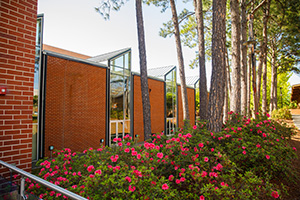 The Corn Center for the Visual Arts was made possible by Columbus State's $100 million
capital campaign. This world-class facility contains 14 different studio and work
spaces for Department of Art students and faculty, including a fully equipped ceramics
studio; printmaking studio; sculpture fabrication studio; 3,000-square foot Illges
Gallery; student exhibition space; and an outdoor exhibition space. Soon to be added
on the second floor is an 8,000-square foot research and exhibition space that will
house the CSU Permanent Collection including the largest collection of Bo Bartlett's
monumental scale paintings, and will serve as home to the Bartlett Center for Research
in Visual Art. This space will also support the department's vibrant Visiting Artists
and Scholars Residency Program (VASRP) and present contemporary exhibitions featuring
acclaimed artists of national and international repute.
The Corn Center for the Visual Arts was made possible by Columbus State's $100 million
capital campaign. This world-class facility contains 14 different studio and work
spaces for Department of Art students and faculty, including a fully equipped ceramics
studio; printmaking studio; sculpture fabrication studio; 3,000-square foot Illges
Gallery; student exhibition space; and an outdoor exhibition space. Soon to be added
on the second floor is an 8,000-square foot research and exhibition space that will
house the CSU Permanent Collection including the largest collection of Bo Bartlett's
monumental scale paintings, and will serve as home to the Bartlett Center for Research
in Visual Art. This space will also support the department's vibrant Visiting Artists
and Scholars Residency Program (VASRP) and present contemporary exhibitions featuring
acclaimed artists of national and international repute.
RiverCenter for the Performing Arts/Saunders Center for Musical Studies
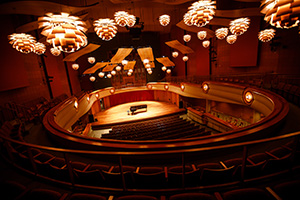 CSU's Schwob School of Music is housed in the Saunders Center for Musical Studies
within the RiverCenter for the Performing Arts. This $78 million facility includes
the city's finest performance, encompassing the 2,000-seat Bill Heard Theatre, the
450-seat Legacy Hall and its magnificent Jordan Concert Organ and a 150-seat Studio
Theatre. All three concert halls enjoy outstanding acoustics and attract large, enthusiastic
audiences each year. The Saunders Center for Musical Studies contains more than 83,000
square feet of rehearsal and instructional space. The facility has been rated among
the finest in the country and offers ample practice rooms, chamber music rooms, Music
Library, recording facilities, classrooms, and faculty studios that bustle with musical
energy. With a recent gift from Maxine Schiffman and the Schiffman Family Foundation,
67 new Steinway pianos were purchased, making the Schwob School of Music an all-Steinway
school.
CSU's Schwob School of Music is housed in the Saunders Center for Musical Studies
within the RiverCenter for the Performing Arts. This $78 million facility includes
the city's finest performance, encompassing the 2,000-seat Bill Heard Theatre, the
450-seat Legacy Hall and its magnificent Jordan Concert Organ and a 150-seat Studio
Theatre. All three concert halls enjoy outstanding acoustics and attract large, enthusiastic
audiences each year. The Saunders Center for Musical Studies contains more than 83,000
square feet of rehearsal and instructional space. The facility has been rated among
the finest in the country and offers ample practice rooms, chamber music rooms, Music
Library, recording facilities, classrooms, and faculty studios that bustle with musical
energy. With a recent gift from Maxine Schiffman and the Schiffman Family Foundation,
67 new Steinway pianos were purchased, making the Schwob School of Music an all-Steinway
school.
Riverside Theatre Complex
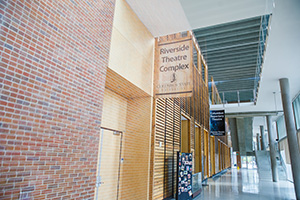 The Department of Theatre and Dance‘s Riverside Theatre and its other world-class
facilities were made possible by Columbus State University‘s $100 million capital
campaign. The Theatre on the Park features a grand, glass-lined lobby overlooking
Woodruff RiverFront Park and the Chattahoochee River. This facility consists of a
350-seat theater with full fly loft, elevator pit and the latest in lighting and sound
technology; a black-box style teaching theater that can seat up to 200, a scene shop,
a costume shop, a lab theatre, a lighting classroom, and other classroom and rehearsal
spaces.
The Department of Theatre and Dance‘s Riverside Theatre and its other world-class
facilities were made possible by Columbus State University‘s $100 million capital
campaign. The Theatre on the Park features a grand, glass-lined lobby overlooking
Woodruff RiverFront Park and the Chattahoochee River. This facility consists of a
350-seat theater with full fly loft, elevator pit and the latest in lighting and sound
technology; a black-box style teaching theater that can seat up to 200, a scene shop,
a costume shop, a lab theatre, a lighting classroom, and other classroom and rehearsal
spaces.
Seaboard Depot Art Studios
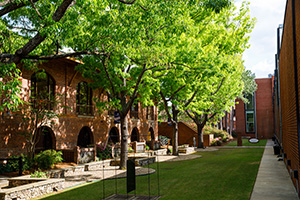 The historic brick building originally called the Seaboard Depot Air Line Railway
Freight Depot was built in 1902 to serve the mill and warehouses in the riverfront
area. A fire destroyed much of the building in 1977. Architect Bill Murphy rebuilt
the Depot to house his practice. With support from the Mildred Miller Fort Foundation
and others, it was purchased by the state and beautifully readapted to house individual
art studios for faculty, students, and visiting artists, the ArtLab gallery, seminar
and workshop space, and classrooms for Art History, Art Education, and Narrative Illustration
& Book Arts. This facility has created an immediate synergy between our students,
faculty, resident artists, and the public, while providing enhanced opportunities
for program growth, exhibitions and presentations, teacher training, productivity,
and community interaction.
The historic brick building originally called the Seaboard Depot Air Line Railway
Freight Depot was built in 1902 to serve the mill and warehouses in the riverfront
area. A fire destroyed much of the building in 1977. Architect Bill Murphy rebuilt
the Depot to house his practice. With support from the Mildred Miller Fort Foundation
and others, it was purchased by the state and beautifully readapted to house individual
art studios for faculty, students, and visiting artists, the ArtLab gallery, seminar
and workshop space, and classrooms for Art History, Art Education, and Narrative Illustration
& Book Arts. This facility has created an immediate synergy between our students,
faculty, resident artists, and the public, while providing enhanced opportunities
for program growth, exhibitions and presentations, teacher training, productivity,
and community interaction.
Woodruff Park
Woodruff park was created as public green space through a partnership between Columbus State University and the city of Columbus. Bordered by the Chattahoochee River and the university's RiverPark campus, this park serves as a lush entrance area to the city's popular RiverWalk. Woodruff Park is available to be scheduled free of charge for non-profit groups organizing events that are free and open to the public.
Pasaquan
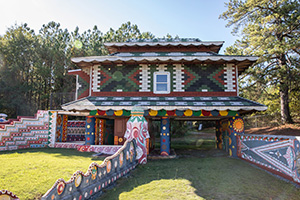 Pasaquan is a seven-acre art environment that consists of six major structures, more
than 900 feet of painted masonry fence, painted totems, decorative walkways, sculptures,
and other art and artifacts. It is listed on the National Register of Historic Places
and is considered among the most important visionary art environments in the United
States. Eddie Owens Martin, who introduced himself as St. EOM, was the creator of
Pasaquan. The Pasaquan Preservation Society operated the site after his death. In
2014, the Kohler Foundation began work on Pasaquan, representing one of their largest
preservation initiatives. The facility will provide opportunities for diverse programming,
becoming a culturally enriching focal point in the region while assisting in economic
development. A large repository of original art and artifacts housed in the CSU Archive
and elsewhere supports the site, and is expected to further contribute to future generations
of researchers.
Pasaquan is a seven-acre art environment that consists of six major structures, more
than 900 feet of painted masonry fence, painted totems, decorative walkways, sculptures,
and other art and artifacts. It is listed on the National Register of Historic Places
and is considered among the most important visionary art environments in the United
States. Eddie Owens Martin, who introduced himself as St. EOM, was the creator of
Pasaquan. The Pasaquan Preservation Society operated the site after his death. In
2014, the Kohler Foundation began work on Pasaquan, representing one of their largest
preservation initiatives. The facility will provide opportunities for diverse programming,
becoming a culturally enriching focal point in the region while assisting in economic
development. A large repository of original art and artifacts housed in the CSU Archive
and elsewhere supports the site, and is expected to further contribute to future generations
of researchers.
The Bo Bartlett Center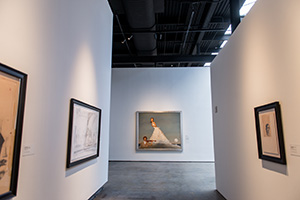
The Bo Bartlett Center is an 18,425 square foot interactive gallery space, housed on the River Park campus of Columbus State University. The red brick, former textile warehouse turned gallery space, designed by AIA award winning architect, Tom Kundig, sits on the banks of the Chattahoochee River in Bartlett's hometown, Columbus Georgia.
As a cornerstone of the College of the Arts' Corn Center for Visual Arts, The Bo Bartlett Center is a pivotal element in the continued emergence of a national and international presence originally established by the College's Schwob School of Music and its Legacy Hall. Complementing exhibitions in the CSU Department of Art's acclaimed Norman Shannon and Emmy Lou P. Illges Gallery, The Bo Bartlett Center serves as an experiential learning center and cultural hub for the visual arts while affording visitors a broad range of arts experiences offered within the College's arts district.